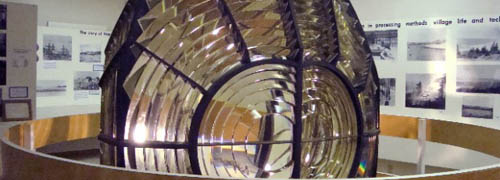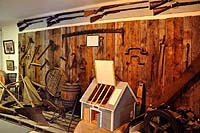 |
|
WALTER
B. McLAUGHLIN MARINE
GALLERY
|
|
The two
floor gallery includes
the history of ship
building, lighthouses
and some of their
keepers, ferries that
have served the island,
and the history of the
first settlers of the
Island. Commercial
fishing from purse
seining, weir fishing,
scallop and ground fish
dragging, and lobster
fishing are all
explained with
informational model
displays. The gallery
has items from the many
vessels that have been
lost at the sea. This
gallery also houses the
spectacular Second Order
Fresnel Lighthouse lens
from Gannet Rock
Lighthouse, and tells
the story of a Grand
Mananer who, because of
his ingenuity, helped to
win WWII.
|
|

2 Story Fresnel Lens, Walter B
McLaughlin Marine Gallery. |
|
|
|
Upper
Marine Gallery:
|
Ship
Building Exhibit:
By 1810, shipbuilding provided
employment for a large number
of island men. Dr. John
Faxon, who arrived at Seal
Cove in 1803, has been
credited with opening the
seawall and building the
largest ship ever built on
Grand Manan, the full-rigged
500-ton John, c.
1811. There were active
shipyards all over the island,
from Deep Cove to North Head,
which were supported by the
increasingly busy number of
sawmills. By 1867 there
were ten steam sawmills
producing lumber on the
island.
The Museum display includes
a model of a typical
three-masted vessel built
and used around Grand Manan
at the end of the nineteenth
century, and a model of the
Nellie T. Watters,
made by Captain Snell of
Grand Harbour and presented
to the Museum by his sons,
Ed and Benjamin Snell of St.
Andrews.
|
|
Curved
wall display on the History
of the Grand Manan Fishing
Industry:
Divided into four
sections, the first is "The
story of Grand Manan begins
and ends with people and
fish"! The second explores
the effects of the
commercial fishing industry
which produced major changes
in processing methods,
village life and technology.
The last two explore
navigational aids and facets
of the modern fishing
industry.
|
|
The Gannet Rock
Lighthouse Fresnel light
The two story light is so
large the Gallery was built
around it. The lens was
originally installed on
Gannet Rock in 1905.
The development of lenses
which refract or bend light
revolutionized lighthouse
technology. Petroleum vapour
under pressure was burned on
a mantle producing 85,000
candlepower - making the
Gannet Rock Fresnel lens the
second most powerful light
in the world when it was in
operation.
|
|
|
New in 2014:
Video Display Console:
NFB Film "Down East Vol.
I". which has a 10
minute Fishery of Grand
Manan segment.
|
|
| |
|
|
|
Lower
Marine Gallery:
|
| |
|
History
of Grand Manan Ferries,
including Lady White Head Ferry
model, donated in 2012 by Ted
Corbett, who oversaw the
construction of the ferry and
made the model.
|
|
|
The
Herring Industry -
Smoked herring used to be a
regular part of life on Grand
Manan’s shorelines, with as many
as 300 smoke houses employing
1,000 seasonal workers.
Spanning 200 years as an
industry, smoked herring was
exported from Grand Manan as
early as 1832. By 1870
larger more efficient smoke
houses were in use leading to
increased production. In
1885 US tariffs were responsible
for the profitable expansion of
trade to the West Indies which
brought dark rum and molasses
back to the island. In
1891 the island produced 1.85
million boxes of smoked herring
(Digby, Nova Scotia produced
only 100,000 boxes), and by 1900
there were 160 producers on the
island, falling to 18 in 1941,
10 in 1946 with only four
remaining by 1995. The
last smokehouse, owned by John
Ingersoll of Woodwards Cove,
closed down in 1996. In
1997 the Seal Cove Herring
Stands were declared a National
Historic Site.
|
|
Gleason Green
Fisherman Exhibit -
Gleason Green (January 21,
1898 - July 17, 1990
came from a large, successful,
family of fishermen who lived
on the Ingalls Head
Road. In 1914, when
Gleason was just 16 years of
age, he bought his first boat,
the “Teaser”, which was custom
built in Nova Scotia, paying
$165 in hard-earned
cash. By the time his
long career was over, Gleason
had owned a total of 21
lobster boats. On
display in the exhibit is a
watercolour by the well known
Canadian marine artist, Oswald
Kenneth Schenk, entitled
“Bonny Bride”, a boat
purchased by Gleason April 3,
1968. Gleason was well
loved by islanders and summer
visitors alike, and was famous
for the fine fish chowder he
served on his boat
tours. Gleason has many
fishing relatives on the
island to this day.
|
|
|
Fishermen's
Knot and Nets Display
- an interactive display. Fun
for museum visitors, but
functional from a fisherman's
point of view.
|
|
Snooks the Diver
Exhibit - The role
of the diver was important in
the maintenance of weirs and
the salvaging of wrecks.
This type of hard helmet
diving suit is no longer
used. Modern divers use
scuba gear which allows them
more independence and freedom
of movement. “Snooks”
the diver began diving at an
early age, around 1917, doing
a lot of weir work and various
other tasks around the island
where he was a familiar
sight. (The bicentennial
quilt on display has a square
dedicated to Snooks in his
hard helmet diving suit.)
The large air compressor
pump on display sat on the
deck of the boat from which
the diver descended. Men
had to pump the air down
through a long hose, and the
“tender”, as he was called,
took care of the air hose, the
life line, and also was
responsible for sending down
tools needed for repair
work. The diver would
request a tool by tugging on
the line, but later years had
a telephone to talk on.
In 1958 Snooks had a heart
attack and was forced into
retirement, but his son,
Erling Green, took over the
job for the next 11
years. Father and son
dove for a combined total of
52 years.
|
|
|
The base
of the Fresnel light
where the petroleum va pour was
stored and burned. The extreme
weight of the Fresnel lens
required the "industrial"
strength base for the light.
|
|
|
The
Fisherman/Farmer Exhibit
- the two lives were a typical
dance for a Grand Manan family -
the two activities provided both
food for the table and economic
activity. The display is
composed of many of the
implements which historically
were used.
|
\  |
|
|
The
Buoys Exhibit
- the lobster buoys representing
some of Grand Manan's fishing
families' colours.
|
|
|
|
|
The
Ship Wreck Gallery
- a history of some of the many
ship wrecks off the shores of
the islands of the Grand Manan
Archipelago.
|
|
|
|
|
|